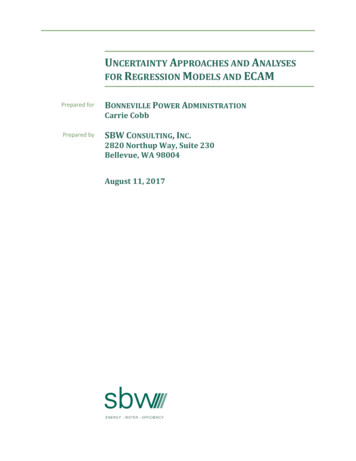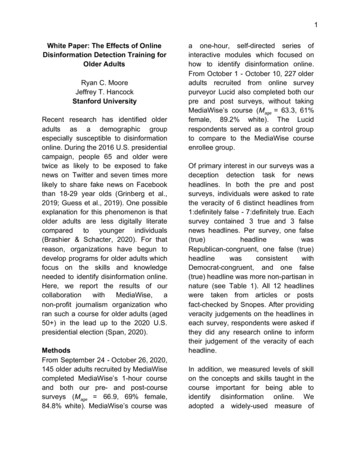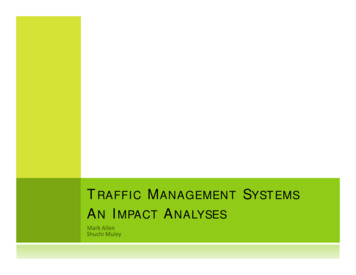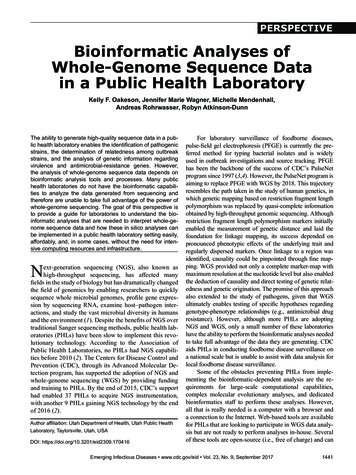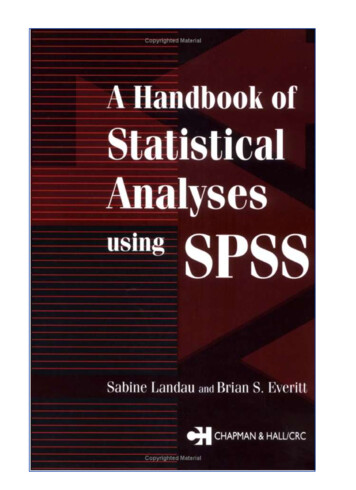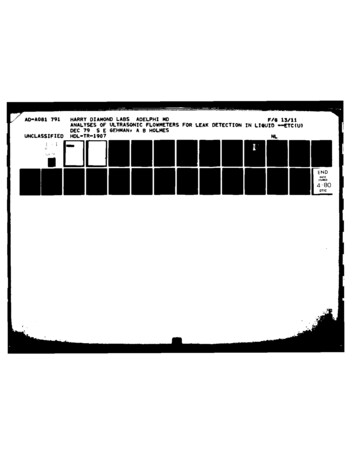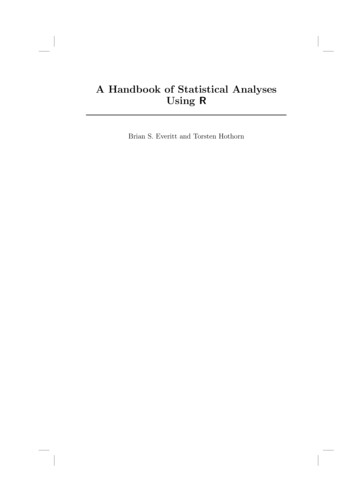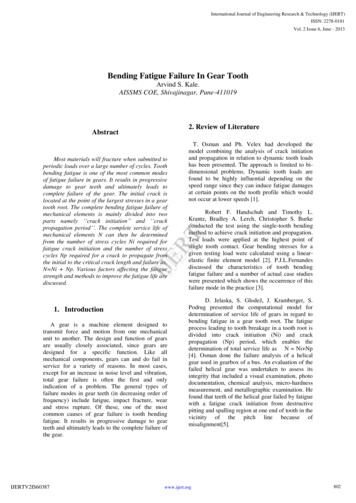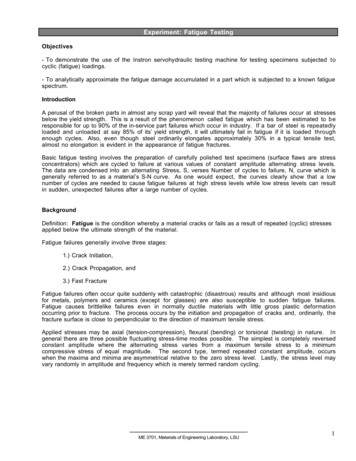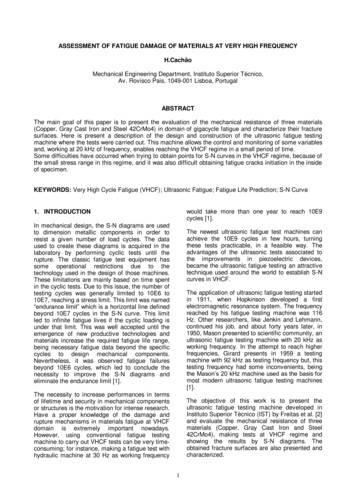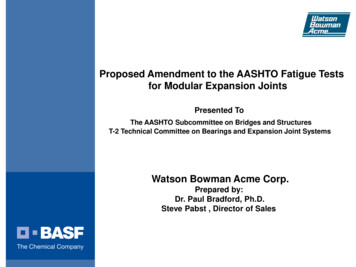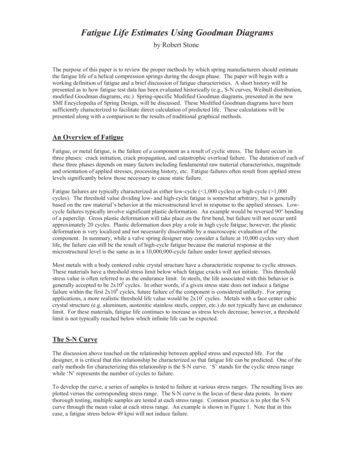
Transcription
Static and fatigue analyses of welded steelstructures – some aspects towards lightweightdesignMansoor KhurshidDoctoral ThesisStockholm, Sweden 2017Division of Lightweight StructuresDepartment of Aeronautical and Vehicle EngineeringSchool of Engineering SciencesKTH-Royal Institute of Technology
TRITA AVE 2017:04KTH School of Engineering SciencesISSN: 1651-7660SE - 100 44 StockholmISBN: 978-91-7729-270-8SwedenAcademic dissertation which with permission of Kungliga Tekniska Högskolan in Stockholm ispresented for public review and doctoral examination on April 07th 2017 at 09:00 in F3,Lindstedtsvägen 26, KTH, Stockholm. Mansoor Khurshid, 2017
Table of ContentsPreface . iAbstract . iiiSammanfattning. ivDissertation. vPublications not included in the thesis . viConference proceedings: . viPeer reviewed Journals: . viDivision of work among the Authors . viiPaper A . viiPaper B . viiPaper C . viiPaper D . viiPaper E . viiPaper F. viiPaper G . viiPaper H . viii1Introduction . 11.1Background . 11.2Research aim . 21.3Research approach . 31.3.1Static strength assessment-testing, selection of base and filler materials . 31.3.2Static strength assessment-Standard methods and numerical models . 31.3.3Fatigue strength assessment-testing and life estimation . 31.3.4Residual stresses in improved welds-Behavior under constant and variable amplitudeloading .31.3.5Residual stresses in improved welds-Effect of process parameters and numericalsimulations. 32Lightweight design concept . 53Material Selection. 743.1Introduction static strength and high strength steels . 73.2Static testing . 93.3Influence of lack of penetration and strength of filler material . 93.4Eurocode3, AWS D1.1, testing and finite element analysis . 103.5Failure criteria for estimating static strength using finite element analysis . 10Fatigue Design Methods . 12I
54.1Introduction fatigue . 124.2Fatigue testing . 134.3Fatigue strength assessment methods . 144.3.1Nominal stress method . 144.3.2Structural hotspot stress method . 144.3.3Effective notch stress method . 144.4Multiaxial fatigue strength assessment methods . 154.5Multiaxial fatigue strength assessment of inclined Butt welded joints failing at the weld root.164.6Fatigue strength assessment of fillet welded tube-to-plate joints failing at the weld root. 16Increased performance by post weld improvement techniques . 195.1Introduction High frequency mechanical impact treatment . 195.2Residual stress measurements- X-ray diffraction technique . 205.3Behavior of residuals stresses in HFMI treated welded joints . 215.4Effect of HFMI process parameters on induced residual stresses . 225.5Numerical estimation of residual stress state induced in HFMI treated welded joints andplates .226Conclusions . 247Contribution to the field . 258Summary of the appended papers. 269Future work . 2910References . 30II
PrefaceThe work in thesis has been carried out at the Department of Aeronautical and Vehicle Engineering,Division of Lightweight Structures, KTH-Royal Institute of Technology, Sweden from September2012 to December 2016. The work done in this thesis is part of European project,”Improving thefatigue life of high strength steel welded structures by postweld treatments and specific filler material” (FATWELDHSS) Volvo Construction Equipment’s project MUD, and Swedish R&D project,”Innovative concepts for lightweight design and fabrication of welded high strength steel structures”(INNODEFAB).Some of the work has been presented and discussed within commission XIII and commission XV inthe International Institute of Welding during the Annual Assembly in Helsinki, Finland in 2015 andMelbourne, Australia in 2016. Part of the work has been awarded finalist paper award at the ASMEInternational conference on pressure vessel and pipelines in Paris in 2013. The work in this thesis isfunded by Volvo Construction Equipment, Cargotec Sweden AB Bromma Conquip, VINNOVA, andEuropean fund for coal and steel. Stresstech Oy, and Sonats are acknowledged for residual stressmeasurements and SSAB is acknowledged for manufacturing and testing test specimens in paper B.First and foremost, I would like to express my gratitude to my supervisor Dr Zuheir Barsoum and cosupervisor Dr Imad Barsoum for their continued support, encouragement, and patience throughout thework. Their trust in me and guidance as scientists, mentors, friends, and elder brothers is greatlyappreciated. Dr Thomas Däuwel at Volvo Construction Equipment Germany, Associate ProfessorMicheal Stoschka and Assistant Professor Martin Leitner at Leoben University Austria, ProfessorGary Marquis at Aalto university Finland, Dr Eeva Mikola at VTT Finland, Professor Cetin MorrisSonsino at Lbf Germany, Assistant Professor Halid Can Yildirim, Professor Muhammad Al Imraniand Poja Shams Hakimi at Chalmers Tekniska Högskolan Sweden, Lasse Souminen (Finland) andPer Lundin (Sweden) from Stresstech Oy, Professor Jack Samuelsson KTH, Dr Christof Schneiderand Dr Joakim Hedegård at Swerea Kimab, Dr Ayjwat Awais Bhatti at Inspecta, Ahmad Mahmoudiand Dr Matthew Doré at TWI UK are highly acknowledged for their discussions during the projectsand sharing authorship in numerous publications. I would also like to thank my colleagues within thedivision of lightweight structures for providing a nice working environment.I am grateful to Dr Elsiddig Emulkashfi Post-doctoral candidate at Oxford University The UK, and DrAftab Ahmad research scientist at ABB and Mathilda Karlsson at KTH for their scientific and friendlydiscussions during my studies. Dr Mehmood Alam Khan Malagori, for scientific discussions andtaking care of me when I got sick during 2015. Izhaar ul Hassan, for helping me out withaccommodation and initial guidance and all the support in Sweden. Without you guys life is Swedenwould have not been so easy.Special and hearty thanks to Katrin Olausson and Emma Drake for being great friends, and teachingme Swedish language. Thank you for all the discussions, fikas, lunches, and dinners during theseyears. Without you guys, I would have not been able to speak the Swedish I speak today and feltintegrated in Swedish society.To Juan Francisco Rodriguiz ,Sherif Fouda, Akbar Khan, Dr Navid Ahmed, Ali Reza Ahmadi, AnisNasir, Dr Iqbal Hussein, Anna Larsson, Anna Ludwall, Simon Hallgren, Daniel Lundel, Herman Rask,Amil Lafeh, Maria Santillana, Yoann Prigent, Awais Mehmood, Seyhmus Bedirhanoglu, and OscarLiedhem. Thank you for your friendship and quality time.i
Last but not the least, I am forever grateful to my parents Dr. Khurshid Ahmed and Saira Bibi, mybrother Dr.Yasir Khurshid and his wife Nosheen Yasir, my sisters Kashmala Yasir and Dr.UroojKhurshid and her husband Dr.Mohsin Sami, my niece Zartasha Yasir, my uncle Samiullah Khan andaunt Seema Sami for their long lasting and unconditional love, support and prayers.Stockholm, January 2017Mansoor Khurshidii
AbstractThis thesis work is concerned with the static and fatigue strength design of welded steel structures.Welded joints in steels of grade S355, S690QT, S600MC, S700MC, and S960 are focused. Severaltopics related to the design of welded joints are addressed such as; influence of filler material strengthand weld metal penetration on the static strength, static testing, fatigue testing, multi-axial root fatiguestrength estimations by nominal and local stress based approaches, multiaxial fatigue strength of jointssubjected to high shear to normal stress ratios, effect of improvement techniques on the fatigue life ofwelded joints, influence of residual stresses on the fatigue strength, and residual stress estimations andmeasurements and their behavior during fatigue loading in improved welds, the effect of materialmodels on the estimated residual stress states in simple plates induced by high frequency mechanicalimpact (HFMI) treatment, and influence of HFMI treatment process parameters on the inducedresidual stress state.The objectives of this thesis comprise of overcoming the challenges in designing lightweight weldedstructures such as material selection, choice of fatigue design methods, and increased performance byusing improvement techniques. Material selection of welded joints is dependent on the filler and basematerial strengths. Partially and fully penetrated cruciform and butt welded joints were designed inunder-matching, matching, and over-matching filler materials. Base material steel grades wereS600MC, S700MC, and S960. Current design rules are developed for welds in steel up to yieldstrength of 700MPa. Therefore, design rules in Eurocode3, AWS d1.1,
Current design rules are developed for welds in steel up to yield strength of 700MPa. Therefore, design rules in Eurocode3, AWS d1.1, and BSK 07 were verified and recommendations for developing design rules for designing welded joints in S960 were concluded. Numerical methodology for estimating static strength of welded joints by simulating heat affected zone was also developed. Another .
